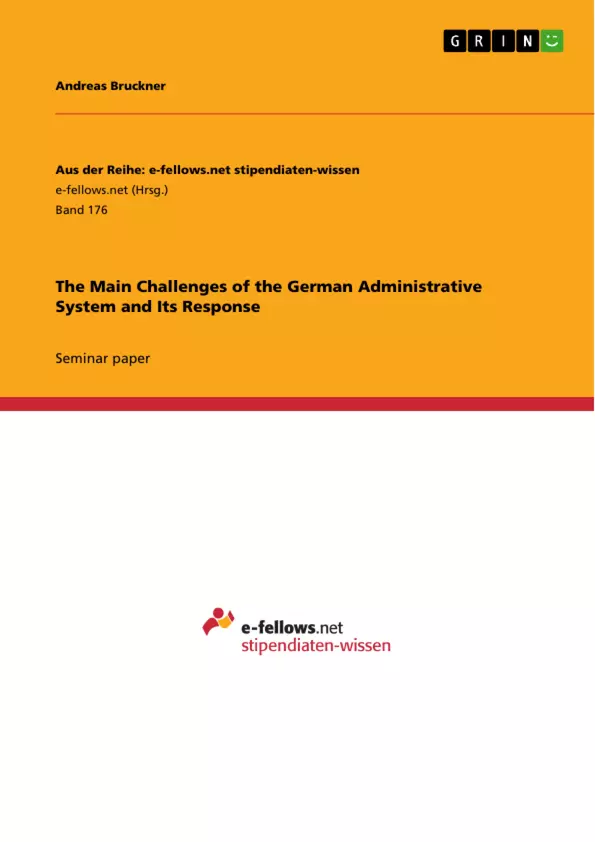This essay aims to analyse the administrative state of affairs in Germany. This is to be achieved in two ways: First by outlining the main challenges of the current German administrative system, and secondly by assessing the German response, or in other words the actions taken. It aspires to contribute to the discourse of Comparative Public Administration (CPA) by giving full attention to a country, which has “not participated in the vogue for administrative reforms as enthusiastically as its Anglo-Saxon counterparts”1 and which quiet and cautious approaches have therefore not been excessively covered by CPA literature.
THE ADMINISTRATIVE SYSTEM IN GERMANY :
ITS MAIN CHALLENGES AND THE GERMAN RESPONSE
This essay aims to analyse the administrative state of affairs in Germany. This is to be achieved in two ways: First by outlining the main challenges of the current German administrative system, and secondly by assessing the German response, or in other words the actions taken. It aspires to contribute to the discourse of Comparative Public Administration (CPA) by giving full attention to a country, which has “not participated in the vogue for administrative reforms as enthusiastically as its Anglo-Saxon counterparts”1 and which quiet and cautious approaches have therefore not been excessively covered by CPA literature.
ADMINISTRATIVE OVERVIEW
Before outlining any German p.a.2 problems and challenges it is methodically desirable to briefly remind us of the distinctive public administrative features in Germany. This will help us to better understand the true nature of the emerging problems and the potential and limitation of the action taken against them.
The administrative structure of the Federal Republic of Germany can be briefly characterized in three principles. The first principle is the ‘separation of powers’, which distributes legislative, executive and judicial powers among separate institutions. This paved the way for the evolution of the so-called Rechtsstaat (‘legal state’), where all public power is subject to judicial control with citizens having access to the system of constitutional courts (on all federal levels) and special administrative courts of justice3. While the administrative body is bound by law in almost all Western democracies, one peculiar German feature is frequently seen in the legalism of the administrative culture 4. The second principle is ‘federalism’: It defines 16 Länder (‘states’) as “members of the federation yet retaining a sovereign state power of their own”5. Thus the federal government heavily relies on the states for the execution of federal policies and for service delivery. The third principle is ‘local self-government’: The right of every Gemeinde (‘local government’) to govern local affairs under its own responsibility. All three tiers (federal, state and community) enjoy a distinctive functional division of power, resources and labour, and a high degree of geographical, vertical and horizontal differentiation. The German Basic Law guarantees Kommunale Selbstverwaltung (‘local self-government’) in terms of territorial, fiscal, planning and legislative autonomy as well as autonomy in personnel recruitment and promotion.
[...]
1 Pollit, C., Bouckaert, G. (2000): Public Management Reform – A Comparative Analysis, New York: Oxford University Press, p. 2.
2 It has become an international convention that PA refers to the academic discipline and p.a. to the actual practice of public administration.
3 Kunig, P. (1986): Das Rechtsstaatsprinzip, Tübingen: Paul Siebeck, pp. 34-67.
4 Derlien, H.U., In: Tummala, K., (2005): Comparative Bureaucratic Systems, Lanham: Lexington, pp. 97-123.
Frequently Asked Questions: The Administrative System in Germany
What is the main purpose of this essay?
This essay aims to analyze the administrative state of affairs in Germany by outlining the main challenges of the current German administrative system and assessing the German response to those challenges.
How does the essay contribute to Comparative Public Administration (CPA)?
The essay contributes to the discourse of CPA by focusing on Germany, a country that hasn't participated in administrative reforms as enthusiastically as some other nations, leading to less coverage in CPA literature.
What are the three principles characterizing the administrative structure of the Federal Republic of Germany?
The three principles are: the 'separation of powers', federalism, and 'local self-government'.
What is the significance of the Rechtsstaat?
The Rechtsstaat ('legal state') is significant because it means all public power is subject to judicial control, and citizens have access to constitutional and administrative courts.
How does federalism influence administration in Germany?
Federalism defines 16 Länder ('states') with sovereign state power, meaning the federal government heavily relies on these states for the execution of federal policies and service delivery.
What is Kommunale Selbstverwaltung?
Kommunale Selbstverwaltung ('local self-government') is the right of every Gemeinde ('local government') to govern local affairs under its own responsibility. It is guaranteed by the German Basic Law and includes territorial, fiscal, planning, legislative, and personnel autonomy.
What is the relationship between PA and p.a.?
PA refers to the academic discipline of public administration, while p.a. refers to the actual practice of public administration.
- Quote paper
- rer. pol. Andreas Bruckner (Author), 2011, The Main Challenges of the German Administrative System and Its Response, Munich, GRIN Verlag, https://www.grin.com/document/176429



